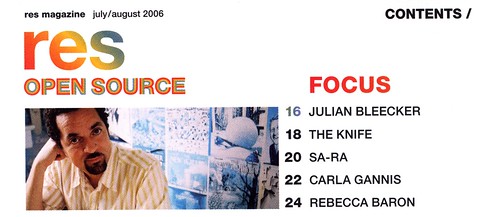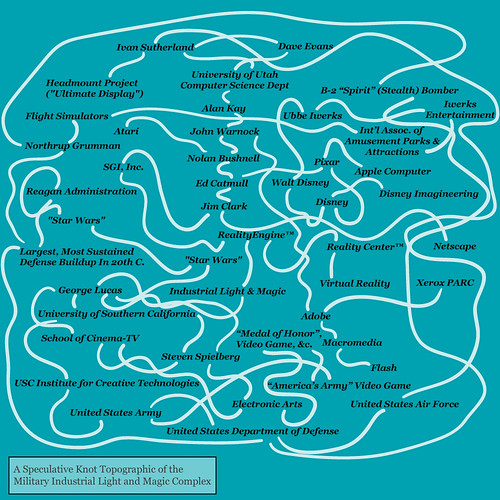
Holly Willis wrote a short profile on me in the July/August 2006 issue of RES Magazine.

Holly Willis wrote a short profile on me in the July/August 2006 issue of RES Magazine.

ACE2006 Keynote: The Military Industrial Light and Magic Complex
permalink
Keynote talk delivered at the 2006 ACM SIGCHI International Conference on Advances in Computer Entertainment Technology, 14-16 June 2006, Hollywood, California.
Slightly modified from the original Keynote presentation, available here:
http://research.techkwondo.com/files/presentations/ACE2006Talk_TheMilitaryIndustrialLightAndMagicComplex.pdf
trackback
Tim Lenoir. 2000. All But War Is Simulation: The Military-Entertainment Complex. Configurations, 8(3), Fall, 2000: 289-335.
http://www.stanford.edu/dept/HPS/TimLenoir/MilitaryEntertainmentComplex.htm
Bruce Sterling. 1993. War Is Virtual Hell. Wired, Mar/Apr 1993.
http://www.wired.com/wired/archive/1.01/virthell.html
Julian Bleecker. Coherent Light: The Cultural Politics of Virtual Reality. Master’s of Engineering Thesis, University of Washington, Seattle. June 1992.
http://research.techkwondo.com/files/CoherentLightTheCulturalPoliticsOfVirtualRealityMastersThesis.pdf
tag cloud
military, entertainment, simulation, virtual reality, telepresence, electronic games, electronic entertainment, virtual worlds, ender’s game, orson scott card, ivan sutherland, katamari damacy, fan culture, 1st Life, 2nd Life, computer graphics, world of warcraft, play, playground, alternative games, social impact games, social practice, embodying social practice
abstraction
The relationship between military and entertainment is well-known and scarcely misunderstood. How has this relationship shaped the production and circulation of entertainment cultures in the early 21st century, wherein digital networked, massively multiparticipatory online games have become social life simulations? Is it possible to learn from the military — eminence in translating 2nd Life experiences (training simulations) into 1st Life action (deployments and operations) so that we breech the 2nd Life/1st Life barrier so as to create tangible actions that mitigate 1st Life catastrophic failure? How can 2nd Life experiences offer productive couplings to 1st Life actions in a way that avoids the dramatic folly of the character Ender from the Orson Scott Card novel Ender’s Game?
ACE2006 Keynote: The Military Industrial Light and Magic Complex
Technorati Tags: military industrial light and magic complex, mixed reality, pervasive electronic games, play, simulation

MOBILE ASIA COMPETITION 2006: ORGANIZED BY ART CENTER NABI, SEOUL, KOREA :: The progress of mobile technology characterized by mobility, connectivity, and dispersion seems to resonate with the diasporic experiences of Asians who are mobile, dispersed yet connected with each other through socio-cultural dynamics and relations. With the mobile market and its culture expanding beyond Korea, Japan, China, and Taiwan to the Southeast Asia, the need should be raised for reflecting upon the currency of culture and the urgency of new identities that are evolving with mobile technology in Asian region.
Mobile Asia Competition 2006 hosted by Art Center Nabi pays attention to the role of media makers and artists in articulating and expressing the Asian mobile cultures. Artists and media makers always appropriate and challenge the given technology through creative ideas and critical practices to broaden the space of possibilities. Especially, the recent emerging ubiquitous mobile environments requires both popular sentiment and critical thoughts. Mobile Asia competition 2006 investigates the new forms of Asian identities and cultures in the creative works of artists and designers who dare to experiment, play, and wrestle with the mobile technologies.
CATEGORY
1. Works made to be viewed and experienced on mobile devices
(1) Game, Interactive Art
(2) Screen-based arts : Animation, Motion Graphic, Documentary, Music Video, Narrative film, etc.
2. Works made by mobile phones such as camera phone, video phone.
3. Idea proposal for wireless art projects on the theme of ‘connectivity and social network’. Art project that expresses the theme of social network and connectivity while exploring new and artistic ways of using diverse personal media such as mobile phones, laptop, PDA and internet network.
PRIZE: The total award money is US $20.000 and the selected works will be exhibited in various on and offline venues.
Category 1 & 2 (Mobile content): US $10.000
– One winner from each category will be awarded with $5000.
– The works by winners and other selected works will be screened and exhibited at Art Center Nabi, ResFest Korea 2006 (digital film festival), and Korean mobile phone service including DMB channel.
Category 3 (Wireless art proposal): US $10.000
– One winner will be awarded with $5000.
– Additional $5000 and technical support will be offered for the realization of the proposal if the work is decided to be realized for the exhibition at Art Center Nabi.
SUBMISSION GUIDELINES
.Category 1 & 2 seek for completed works, and Category 3 for project proposal.
.Projects that are under development will also be considered for Category 3.
.Project proposal should relate to the theme and topics of the Award
.The works that are already presented or won in other competitions are not eligible for entry.
_HOW TO SUBMIT
.All submissions should be processed through the official online platform.
.Biography, project proposal, and other supporting materials (image, sound, movie files) should be uploaded in appropriate format indicated in each section.
.However, the works applying for Category 1 & 2 should be sent via registered mail in the format of CD-Rom, DVD, Mini DV tape with a copy of filled-out online registration form printed from the website.
Please go to http://www.nabi.or.kr/pages/submission.asp to complete your submission. (all submissions)
Mail address (Category 1 & 2 only):
Art Center Nabi [Att: Mobile Asia Competition 2006]
99 Seorin-dong, Jongro-ku, SK bldg. 4th fl.
Seoul, Korea
110-110
_IMPORTANT DATES
Deadline for Submissions
.Category 1 & 2: August 31, 2006
.Category 3: July 31, 2006
Notification of winners September 15, 2006
CONTACT: For more information, please visit www.mobileasia.org.
Or contact at mobileasia[at]mobileasia.org
Art Center Nabi
99 Seorin-dong, Jongro-ku, SK bldg. 4th fl.
Seoul, Korea
110-110
www.nabi.or.kr
Technorati Tags: Art Center Nabi, art technology, mobile
Just saw on Nicolas’ place that an early beta (what’s the difference between any beta anymore..) Jyri Engestrom and his posse’s Jaiku rich presence application for Series 60 2nd edition devices has been released..very nice. I just downloaded the client to this N70 + T-Mobile I’ve been poking around with and it makes me want to officially switch off of Sprint. For good.
[wikilike_img src=http://tecfa.unige.ch/~nova/img/jaiku.png|align=thumb tcenter|width=211|caption=Jaiku|url=http://www.jaiku.com]
We invented the term ‘rich presence’ to describe the many relevant things a phone knows about you. Rich presence on Jaiku includes an IM-style away line, your phone profile (ring volume, vibrate), location (country, city/region, neigborhood), Bluetooth devices around, upcoming calendar events, and the duration how long your phone has been idle.
You can view your contacts’ rich presence on jaiku.com, and once you have signed up, you can download a free client application for Nokia Series 60 Second Edition phones.
Why do I blog this? Presence awareness is the breakfast cereal of the millennials and Jyri and the like are the new Kellogg’s.
Technorati Tags: mobile social software
I’ve started working on a bit of summer laboratory experiment to see how Google Earth could become a platform for realtime mobile gaming. (Follow the link on the Flickr photo page to the URL you can load in your Google Earth client to see the game board in its current state.)
With Google Earth open enough to place objects dynamically using the tag, a bit of SketchUp modeling and borrowing an enormous battleship model that construction dude uploaded to the SketchUp/Google 3D Warehouse, I started plugging away at a simple game mechanic based on the old Milton Bradley Battleship game.
Battleship, for those of you who never played, has a simple mechanic — two players set up their navy ships on a peg board, hidden from the other guy. You take turns plugging a peg into your side of the board, with each peg hole designated by a letter/number coordinate grid. When you plug a peg in, you say where you put it — E4! If your opponent has a ship in that coordinate (or part of one, actually), they say, sorrowfully, “Hit!” and you register that peg hole with a color to indicate a hit. If not, you just put in a neutral peg to remind you that you already tried that spot. The game continues into one player has sunk all the other guys ships.
The mechanic I’m experimenting with is simpler. One person places their ships using Google Earth and the other person goes out in the normal world with a mobile phone, a GPS connected to the mobile phone. The phone has a small Python script on it that reads the GPS and sends the data to the game engine, which then updates the Google Earth KML model showing the current state of the game grid. When the player who’s trying to sink the ships wants to try for a hit, they call into the game engine and say “drop”. The game reads back the coordinates at which the “peg” was dropped and shortly thereafter, the other player will see the peg appear at the coordinate it was dropped. If the peg hits one of the ships, it’s a Hit, otherwise it’s a miss.
[ad#ad-4]
Next Steps
As I continue developing the engine, I’ll probably have the game engine let you know when you call in to do the “drop” whether it was a hit or not, or the opposing player can text or call to indicate the same.I want to put in a “ping” command for the call-in battleship control center to help whoever’s wandering around in the world navigate a bit. (Although the game is only really practical if you limit the boundaries over which it can be played.)
I need a lighter weight battleship — the current SketchUp model is too large, in data size terms and takes too long to initially load (although, it only needs to be loaded once.)
Goals
* Experiment with “1st Life” action reflected in “2nd Life” worlds (verso of the folly Ender suffered in Orson Scott Card’s simply fascinating Ender’s Game
* Learn KML
* Learn SketchUp
* Learn Python for S60
* Make a mobile/pervasive game in which one has to move around in order to play Equipment
* Google Earth client
* Apache+Tomcat+MySQL (Java and JSP on the server-side computer)
* Nokia N70 and a little Python app to connect to the Bluetooth GPS and upload the data to the server
* Voice Application (for the battleship control center to drop/ping)
* SketchUp Time Committed
* About 2 days learning stuff, and 1/2 a day programming the computer to make it do things.Why do I blog this?To keep track of and share the near future laboratory experiments I’m doing this summer.
Technorati Tags: mobile, pervasive electronic games, pervasive media, play, urban play